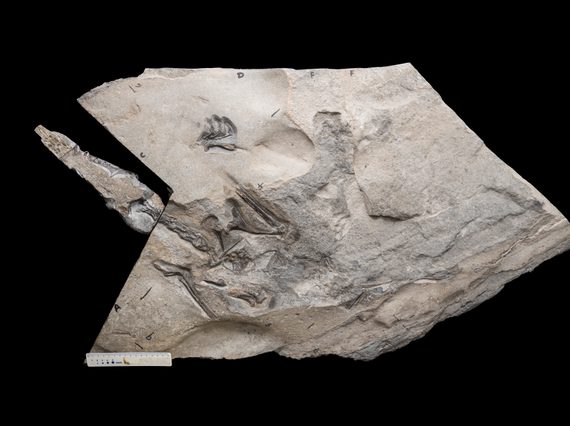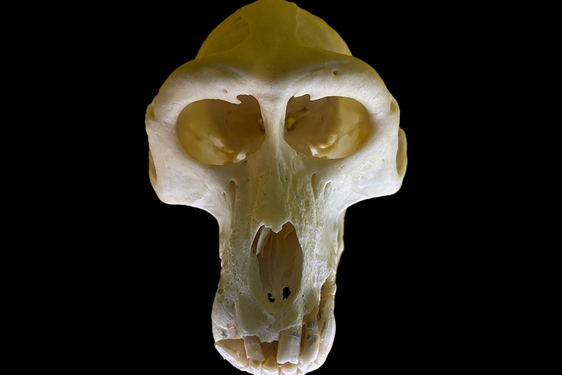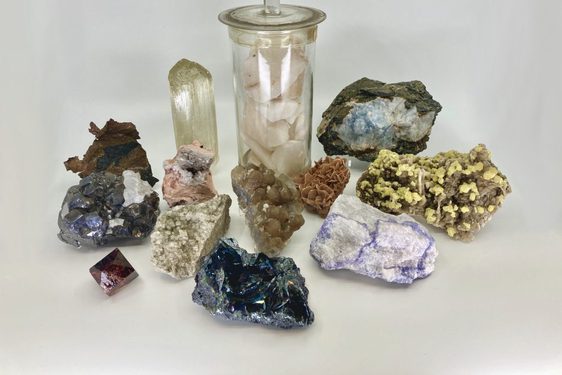
Illuminating the ‘dark age’ of pterosaur evolution: an exceptional skeleton from the Middle Jurassic of Skye, Scotland
Dr Natalia Jagielska successfully defended her thesis in 2024 after 4.5 years as a PhD student at the University of Edinburgh and co-supervised by National Museums Scotland.
Last updated: 18 February 2025
About the research
Pterosaurs - commonly known as ‘pterodactyls’ - are some of the most iconic extinct animals. These dinosaur cousins were the first vertebrates to evolve flight, and thrived for over 100 million years during the Mesozoic Era. Very little is known, however, about their evolution during the Middle Jurassic, due to a global lack of fossils. This is frustrating because this interval was likely a critical time in pterosaur history, when they transitioned from small, long-tailed, primitive forms into the great diversity of species that characterized their Mesozoic heyday.
Our team discovered the most complete skeleton of a Middle Jurassic pterosaur from the UK - and one of the most complete worldwide - in the Lealt Shale Formation of the Isle of Skye, Scotland. It revealed important insights into the anatomy, relationships, feeding habits, flight abilities, and favoured habitats of Middle Jurassic pterosaurs. The project comprised a detailed study, description, and identification of the new specimen, and used it as a springboard to examine the relationships and evolution of Middle Jurassic pterosaurs more broadly.
- Project title
Illuminating the ‘dark age’ of pterosaur evolution: an exceptional skeleton from the Middle Jurassic of Skye, Scotland
- Student
Natalia Jagielska
- Project active
2019 - 2024
- Funder
NERC Edinburgh Earth, Ecology and Environment (E4) Doctoral Training Partnership
- University Supervisors
Dr Stephen Brusatte and Dr Mark Wilkinson - School of GeoSciences
- National Museums Scotland Supervisor
- Research theme
Sustainability
Publications
Jagielska, N., Kaye, T.G., Habib, M.B., Hirasawa, T., Pittman, M. 2024. New soft tissue data of pterosaur tail vane reveals sophisticated, dynamic tensioning usage and expands its evolutionary origins. eLife 13. https://doi.org/10.7554/eLife.100673.2.sa2
Jagielska, N., O'Sullivan, M., Butler, I.B., Challands, T.J., Funston, G.F., Ross, D., Penny, A., and Brusatte, S.L. 2025. Osteology and functional morphology of a transitional pterosaur Dearc sgiathanach from the Middle Jurassic (Bathonian) of Scotland. BMC Ecology and Evolution 25: https://doi.org/10.1186/s12862-024-02337-9
Jagielska, N., Challands, T.J., O’Sullivan, M., Ross, D.A., Fraser, N.C., Wilkinson, M and Brusatte, S.L. 2023. New postcranial remains from the Lealt Shale Formation of the Isle of Skye, Scotland, showcase hidden pterosaur diversity in the Middle Jurassic. Scottish Journal of Geology 59: https://doi.org/10.1144/sjg2023-001
Jagielska, N., O’Sullivan, M., Funston, G.F., Butler, I.B., Challands, T.J., Clark, N.D.L., Fraser, N.C., Penny, A., Ross, D.A., Wilkinson, M. and Brusatte, S.L. 2022. A skeleton from the Middle Jurassic of Scotland illuminates an earlier origin of large pterosaurs. Current Biology: https://doi.org/10.1016/j.cub.2022.01.073
Project contact
Dr Nick Fraser
Lead image: Dearc Skeleton Main Block - credit Gregory Funston
Natural Sciences news and stories
- Discover

6 world-class type specimens in our stores
Written by Dr Andrew Kitchener, Dr Rachel Walcott & Dr Andrew RossType specimens are among the most important objects in natural science collections. They are the specimens on which the scientific names of species of animals, plants or minerals are based. Animals and plants are named using the Linnaean… - Discover

What's in a firework? Minerals that bang
Written by Emily BrownSo, you light a firework, you stand back and WHOOSH, off it shoots into the air. A few seconds wait and then BOOM, the firework explodes in a shower of coloured sparkles raining down from the sky. To get this sequence of events, you need… - Discover
Abernethy Pearl: Scotland's largest freshwater pearl
Written by Dr Rachel WalcottIn 1967, Bill Abernethy was pearl fishing near the River Tay when he came across his rarest and greatest discovery. At a weight of 43.6 grains, the Abernethy Pearl is the largest freshwater pearl found in Scotland in modern history.
